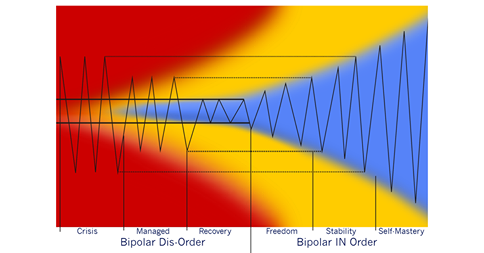People in remission are still considered to have bipolar disorder.
My recent article called “Why I Am Against Bipolar Meds” turned out to be less controversial than I expected. Some people refused to read past the title and that is unfortunate because the vast majority of those who commented said that it was a very fair assessment of both sides of the debate. There were several misconceptions, though, that need to be cleared up.
I mentioned the three stages of Bipolar Dis-Order and the three stages of Bipolar IN Order assuming most of the readers are familiar with the terms and my work. Unfortunately, that was not the case for many readers. In trying to keep the article to under 1000 words, I did not go into detail regarding the stages and what I mean by Bipolar IN Order.
This caused confusion for several psychiatrists who assumed that Self-Mastery means remission. At the other end of the scale were several people with Bipolar Dis-Order who declared that they were in Self-Mastery when their statements seemed to contradict their self-assessment. It seems greater detail of the Bipolar IN Order concept is warranted.
Why “Recovery” Still Means Dis-Order
The primary objective for someone with Bipolar Dis-Order is to lower the intensity of mania and depression and move away from Crisis toward Recovery. Bipolar IN Order is about becoming more functional in an expanding range of intensity and moving from Recovery toward Self-Mastery.
The Stages of Bipolar Dis-Order
There are three stages of Bipolar Dis-Order. Crisis Stage is when you have lost control to the extent that you are a danger to yourself and others. Managed Stage is when you have learned to use tools to keep the intensity of mania and depression below that which causes crisis. Recovery Stage, as defined by the National Institute of Mental Health(NIMH), means you have limited the intensity of mania and depression so much that you are completely or nearly symptom free. By their definition, Remission and Recovery mean the same thing with the central premise that everyone in Recovery Stage (and Managed Stage) is in constant danger of slipping back into Crisis (relapse). People in Recovery are still considered to have Bipolar Dis-Order.
The Stages of Bipolar IN Order
The three stages of Bipolar IN Order are completely different. Moving beyond Recovery, Freedom Stage begins with learning to take small supervised steps into 10%—20% intensity for both mania and depression (typically far below what most are initially able to perceive), then step immediately back into Recovery using our own skills. Stability Stage is when we are highly functional during intensities that once created Crisis. Self-Mastery Stage is when we are highly functional during depressions and manias approaching 100% intensity, which is considered impossible by those who only know Bipolar Dis-Order.
The National Institute of Mental Health (NIMH) has determined Recovery to be an unstable state in their landmark STEP-BD study: “According to the researchers, these results indicate that in spite of modern, evidence-based treatment, bipolar disorder remains a highly recurrent, predominantly depressive illness.”
Why Recovery Shouldn’t Be the End Goal
Recovery is a tremendous achievement that anyone should be proud to have accomplished, but it should not be taught as the end goal when those in Recovery so often end up in another Crisis. I am fundamentally opposed to Recovery being the end goal because from the perspective of Self-Mastery it is acceptance of a diminished life far below what is possible.
There is no danger of relapse in Self-Mastery because there is no level of intensity that can cause a crisis for us; we live in a wide range of intensities of both mania and depression and are highly functional and comfortable in all of them. We do not suffer in the states like those in Dis-Order do.
What Self-Mastery Really Looks Like
Many people claim to have Bipolar IN Order when they first hear the term, but they are usually mistaken. Graduating to IN Order requires the students to clearly distinguish between each level of intensity from 10 percent to 90 percent in increments of ten. They must be able to show a high level of awareness and enhanced level of functionality at each intensity, behave in ways that make those around them comfortable with their state, find value in both past and current episodes, and show deep understanding of the physical, mental, emotional, spiritual, social and career/financial aspects of it. They also must be able to accurately estimate how long they can stay at each level before it escalates and demonstrate effectiveness with tools to moderate the level of intensity before reaching levels beyond their abilities.
Ours is not a quick-fix program. There is a tremendous amount to learn to truly have Bipolar IN Order. While it is relatively easy to teach people how to enter Freedom Stage, it is much more difficult to reach true Stability. Only the most advanced students make it to Self-Mastery, which is very much the same with basketball or any other sport. Performing at the top level of any endeavor takes tremendous skills and hard work. It almost always means learning from someone who has already accomplished it, which is where we come in.
Our Mission and the Path Forward
It is our mission to help people change their thinking and behaviors so they can lead extraordinary lives. We have already proven that far better outcomes are possible and have created a clear path to achieve them. Recovery is part of that path, but Self-Mastery should always be held as the ultimate goal.
A short article cannot begin to share the depth and complexity of Bipolar IN Order, nor explain the assessments, tools, and stage specific plans that will help you to achieve it. If you would like to look much deeper into the topic there is a Bipolar IN Order course available at the Bipolar Advantage website.

